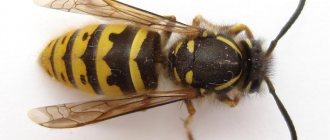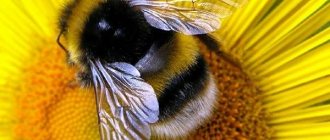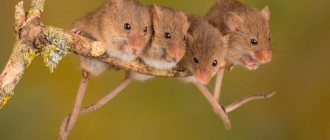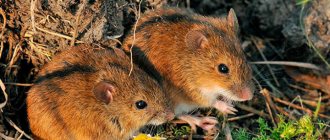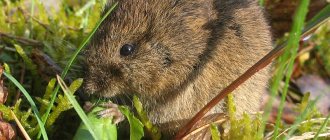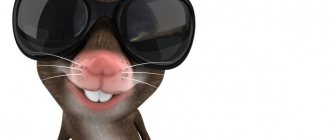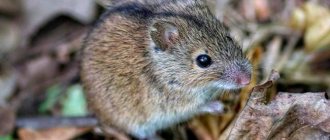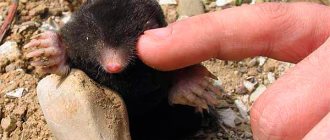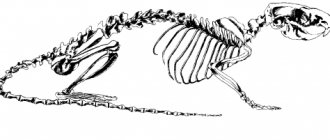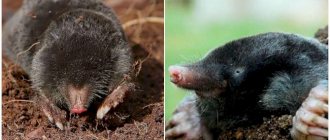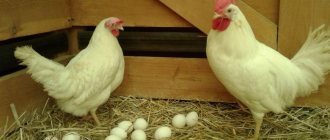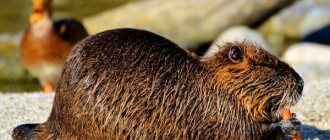How favorable the winter will be for the mouse depends on whether it was able to find suitable housing with a sufficient supply of food in the fall. The ideal option is a warm human home, a cellar, a barn or a room for keeping animals.
Under natural conditions, rodents have to independently take care of their own survival during the cold season.
Field mouse: description
Description of the field mouse:
- Body length no more than 12 cm, excluding tail. The thin tail makes up 70% of the body length.
- The body is oblong. The hind feet are elongated and protrude forward when running.
- Long muzzle, small round ears, oblong nose.
The fur is hard, rough, short. The colors can be different - gray, brown, ocher or beige. A straight line of black or brown shade runs along the spine. The color of the abdomen is snow-white. At the base the hairline has a dark tint. Small spots may be present on the chest.
This is interesting! The shade of the animal's fur depends on its age. The older the field mouse, the lighter its fur. With age, the dark base of the hairline begins to lighten. Individual hairs may be gray.
The vole mouse has unique teeth ; a pair of long incisors on the lower jaw grow throughout its life. To prevent their excessive growth, and they grow at a rate of 1-2 mm per day, the mouse is forced to continuously grind them off against hard objects.
As for weight, the average animal does not weigh more than 20 grams.
Photo
Distribution of animals
This representative of the fauna is widespread in Europe. Animals can also be found in China, Mongolia, Denmark, Finland, Korea, and Taiwan. In the Russian Federation, the rodent is distributed in Primorye, Siberia, and the Urals. Often settles on the hills, climbs low into the mountains.
Found near the Black and Azov Seas. Does not like deserted forest-steppes and continuous forests. It takes root well in moist interfluves .
It prefers overgrown meadows with small depressions, collective farm fields, sunny edges of deciduous forests and, of course, vegetable gardens. It can be found in greenhouses, greenhouses, cellars, barns, abandoned utility sheds and even in residential premises.
IMPORTANT! With the onset of autumn, rodents move into stacks, haystacks, and stacks of straw.
Reproduction
The breeding season for the vole mouse is from early spring to mid-autumn. In one season, the animal is capable of producing 3-4 offspring . In rare cases, up to 5-6. Gestation of the cubs lasts 21-23 days. One litter usually produces 5-7 babies.
Babies are born helpless and blind, but they develop very quickly.:
- 12-14 days after birth they begin to see clearly.
- 30 days after birth they become independent.
- Young individuals are capable of giving birth to cubs within 90-105 days after birth.
How long does a field mouse live? The lifespan of a field mouse can reach 7 years, but in the wild the animals usually live for a year or two.
Now imagine how quickly rodents can multiply in just one summer season, provided there is an abundance of food and sun.
What kind of homes do they have?
Yes, rats and mice do not sleep in winter. They move quickly around the premises. In principle, they prefer to be inside the building, but they often have to run outside to look for food.
They make their home close to food sources, so that no predators can reach them. They especially love the places between walls: they can move freely, mate, store supplies, raise offspring and disturb a person at night.
Lifestyle
In summer and spring, field mice are active in the evening and at night. In autumn and winter they can be active during the day. They do not hibernate.
How mice and voles overwinter:
- Natural shelters or earthen passages can be used as burrows.
- Their burrows reach 3-4 m in length and have 2-4 exits, one of which leads to a watering hole.
- Dwellings must have a nesting chamber and 2-3 pantries in which winter supplies are stored.
- The storerooms are located at a depth of 0.5-1 m.
IMPORTANT! Rodents that live in swampy areas do not dig burrows. They build nests. The main material is grass. Such dwellings are usually located on tall bushes.
Distinctive features
Vole mice have their own characteristics that are distinctive from other rodents.:
- Depending on their habitat (eastern and western), individuals have different colors and sizes.
- It differs from other rodents by the presence of a smooth stripe along the spine.
- Unlike mice, it has a larger body size.
- It differs from the Dahurian hamster in its longer tail.
- Unlike pieds, it has a longer period of puberty - about 100 days.
- Compared to other subspecies of rodents, the field mouse has an underdeveloped ear.
- Field mice have coarser fur. And adult individuals often develop soft spines, like hedgehogs.
- Field mice belong to the mobile subspecies. They are characterized by seasonal feeding movements.
- May be common in swampy areas. At the same time, they use grass nests as burrows.
Very often, other species of mammals that look similar to voles are mistaken for mice. The most common types of rodents that resemble mice in appearance are :
- Earth rat. Despite this name, this animal actually belongs to the mouse family, but differs from voles in its larger size.
- Mole voles. Lives underground and belongs to the hamster family.
And also rodents from the vole family:
- Yellow and steppe variegated. They are similar in appearance to mice, but have a number of distinctive features. Read more about pestles here.
- Red and bank voles. Forest dwellers, differing from the field ones in the color of their fur coat.
- Housekeeper vole. This species lives in colonies and is capable of making significant, up to 15 kg, reserves for the winter.
- Gray vole.
Read about different types of voles here.
Food at different times of the year
The field mouse eats a variety of foods, the choice of which depends on the season.
| Forest |
|
| Taiga | The taiga mouse differs from its relatives in its reddish coat color. This mouse eats: |
| Winter | The rodent settles closer to living quarters and grain folds. It feeds on grain, straw, and root crops stored by humans. |
| Spring and summer | At this time of year, the vole rushes to the fields, where it can feed on the roots of crops. At the same time, it causes enormous damage to crop yields and farming. It also feeds on insects and plant stems. |
| Autumn | The best season for food. |
At this time, the harvest takes place; all the fruits in the gardens are ripe. The vole feeds on grain, seeds, and root crops.
Ways to fight and protect
The main difficulty in the fight against field mice is that they live in places hidden from human eyes. This means that catching or poisoning them is quite problematic. Therefore, the primary task in the fight against voles is the need to find and destroy their housing . You can do this in the following ways.
We drive mice away from the territory
First of all, you need to try to drive rodents out of the area:
- Mow tall grass, remove dry leaves and weeds. You also need to get rid of branches and piles of plant debris. All of these are great places to build burrows.
- Fruits that have fallen from the tree should not remain on the site, as they are an easily accessible source of food for voles.
- Digging up the area can help get rid of holes and underground passages.
- To prevent rodents from damaging fruit trees, a fine mesh net is dug into the ground around the trunks. The same can be done around the perimeter of the entire site.
We use repellers
The use of special repellent devices can speed up the process of expelling voles from your territory. They are installed around the perimeter of the site and provide protection from moisture.
We use mousetraps
Ordinary mousetraps can also help in the fight against mice. Experienced gardeners recommend installing these devices on the site in early spring and late autumn , since it is at this time that mice reproduce most actively. To prevent harm to pets, mouse traps can be covered with a box; this will not stop mice in pursuit of the bait.
We use poisons
At the end of winter and beginning of spring, the use of poisons is very effective. At this time, mice are hungry and not very picky about food. Poisons are placed directly in burrows.
Video
In the video you can see what field mice look like:
- From what I know they make supplies for the winter:
- squirrels
- hamsters
- badger
- bee
- hedgehogs
- gophers
- Bears hibernate before they accumulate fat.
- raccoons
- caresses
- rodent haymaker
- the Siberian shrike bird uses the most terrible way to store its prey - it strings killed mice, insects, frogs on the thorns of bushes
- The following animals make provisions for the winter:
- these are mice
- hamsters
- squirrel
- chipmunk, but their reserves do not always go entirely to them; it happens that the bear is not averse to eating their reserves, and may also swat the chipmunk.
- bees
voles
nothing else comes to mind.
In winter, many animals also want to eat.
Because of the cold and snow, they cannot eat like they did in the warm season.
Therefore, animals make supplies for the winter.
Such animals include: squirrel, mink, weasel, mole, chipmunk, hamster, mice, bees and some other animals.
I’ll try to answer the question: Which animal stores for the winter?
- Squirrel (hazelnuts, cones, mushrooms);
- Mouse (grain);
- Badger (plant roots, acorns, seeds);
- Beaver (in winter it swims underwater and eats the roots of aquatic plants and branches stored in the fall);
- Bee;
- Chipmunk (pine nuts, acorns, etc.);
- Mole (worms);
- Hamster (grain, potatoes, carrots, corn and other products).
? First of all, these are rodents:
- hamsters, mice, voles,
mole,
Squirrel (in our park they take nuts right from our hands in the fall and immediately bury them).
Hedgehogs (they hibernate in winter and in all children’s pictures they carry mushrooms and fruits on their thorns). All kinds of rodents make supplies (hamsters, gophers, badgers, chipmunks, mice, rats). Well, honeycombs are a super store for bees for the winter.
Probably it’s not entirely possible to call bears, they have a reserve before going to bed not in bins, but in their own home; before hibernation, a bear eats up, accumulates fat, and in winter sleeps and sucks its paw.
- Protein - from nuts and mushrooms.
Mice are made from grains and twigs of straw for warmth.
and others…
All kinds of rodents, mice, hamsters, badgers, raccoons, gophers, moles, beavers, chipmunks, voles, gerbils, and pikas make reserves for the winter. Squirrels also procure mushrooms and nuts, and bees procure honey. Weasels and stoats store supplies from mice, black polecats from frogs, muskrats and otters store fish under the ice.
It turns out that sometimes the most unexpected things can be learned about animals familiar from childhood.
rodents prepare supplies for the winter
: mice, hamsters, squirrels, chipmunks (which sleep in winter, like bears), minks, moles, beavers.
Insects
: bees always provide food for the family for the winter, storing honey in much larger quantities than they need for wintering. Therefore, a person also gets healthy honey.
Wasps
lay eggs in living caterpillars that are paralyzed by them.
And gall flies
feed future offspring with their own flesh.
The Bears
accumulate fat reserves, diligently eating before hibernation. And during the winter season they do not eat until spring.
Several animals stock up for the winter, such as squirrels, minks, moles, bears, chipmunks, and other rodents, insects and even birds. Each species has its own escape routes. For example, bears hibernate, birds go south, and the rest prepare supplies for winter, and wait it out underground.
Minks also collect food for the winter, but they are a predator and their winter supply is many times greater than that of squirrels, their supply is frogs, minks bite them in the part of the head where nerves accumulate, thereby the frogs become paralyzed, after which they are lowered not deep to the bottom of the river They also store carcasses of birds, rodents, and fish, often stealing them from fishermen.
Moles are animals that feed on insects, and although they are small in size, this does not interfere with their huge appetite. At a time they can eat as much food as their own weight. Therefore, they cannot do without large winter reserves; they prepare canned food from their favorite food such as earthworms. Moles, like minks, bite the brain nerve, immobilizing the worms and dragging them to their places where they can be stored all winter.
Chipmunks, preparing for the cold, make reserves of pine nuts and seeds; several buckets are enough for them throughout the winter. They can dig a hole for their food all day long, but these holes are often attacked by bears. In winter, chipmunks can wake up to have a snack and go back into sleep. So they have enough reserves for early spring, at a time when other animals have to look for it.
- Brief history of the city of St. Petersburg
At all times, St. Petersburg deservedly had the title of the most amazing, brilliant and sometimes mystical city. Having experienced coups, revolutions and barbaric devastation, St. Petersburg still remains the most beautiful city in the world. - Report on the dangers of smoking message
Cigarettes and tobacco in general have a huge negative impact on the human body. Although many people do not believe that smoking has serious consequences, scientists have long proven that this is not the case.
The field mouse is a small rodent distributed throughout the world. Refers to the most numerous species of mammals - mouse classification. There are more than 100 species on earth. They adapt perfectly to any living conditions. There are no mice only high in the mountains, in areas covered with ice.
How to get rid of field mice in the house?
If you have mice in your home, use time-tested, traditional methods.:
- Mousetraps. At the same time, do not forget about safety measures so that people and pets do not get hurt.
- Repellers. Special devices are safe for people and pets, but have a negative effect on mice.
- Poisons can be used if all precautions are taken.
- Cat. The most effective, proven and safe “remedy” for mice. If you don't have a cat at home, borrow one from friends for a while.
Thus, it is quite possible to get rid of mice on your property or in your house. It is enough to create unbearable living conditions for them. And to prevent voles from appearing again, prevention is needed - maintaining cleanliness in the area, timely removal of plant debris and food waste.
Sabotage
Field mice, if not controlled, cause enormous damage to agriculture. At the same time, they not only eat the crop, but also dig holes, numerous ones, causing damage to the root system of various crops.
With the arrival of winter, if mice sneak into storage areas, which is not difficult, they can destroy up to a third of the supplies. At the same time, they contaminate food products with urine and feces, making them unfit for consumption.
It is important to know! The vole mouse does not bite and at the first danger it tries to quickly hide in its shelter. But if the animal is driven into a corner, it will definitely defend itself. At the same time, we must remember that rodents can infect humans with viruses, bacteria and infections, as well as serious illnesses.
